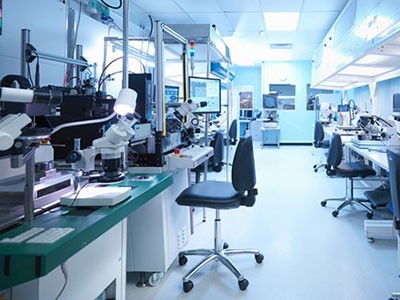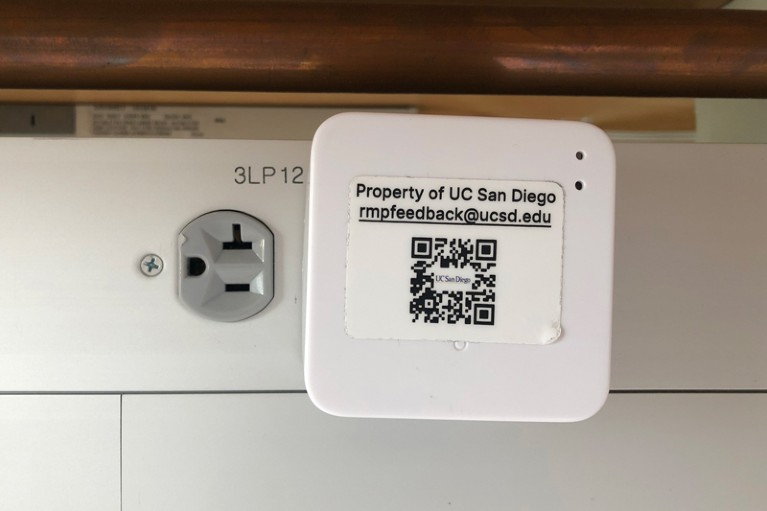Staff members and students protest outside the Lipsius building at Leiden University in the Netherlands in December 2021.Credit: Marc de Haan
In April, staff members in the Bancroft building at Queen Mary University of London (QMUL) received an e-mail telling them that sensors were going to be installed in their offices.
Stuart Grieve, a geographer at QMUL who uses computational and modelling techniques to understand how environmental change shapes planetary surfaces, was shocked both by what he saw as an attempt by the university to begin surveilling students and faculty and by the lack of consultation.
“There was a sudden flurry of e-mails and conversations: the head of the department didn’t know anything about it, the school manager didn’t know. It came from the top, and it was very matter of fact — as if someone was coming to change a light bulb,” he says.
At QMUL — like many other institutions — space is at a premium. University authorities wanted to find out, because of the increase in remote working after the COVID-19 pandemic, whether some of their prime assets — their buildings — were being used to their full potential.

Collection: Coronavirus and scientific careers
A month before QMUL announced that it was installing sensors, the Institute for Public Policy Research, a UK think tank, published a report showing that both physical and digital monitoring of workplaces mushroomed in all sectors during the pandemic — from employers taking remote screenshots of their workers’ computer screens to GPS tracking of equipment and bag checking.
But for Grieve and many of his colleagues at QMUL, these sensors — or cameras, as they call them — have a Big Brother, dystopian feel. They are concerned by the invasion of privacy as well as by what will happen to the data gathered in their offices, laboratories and seminar rooms.
“We’ve had a lot of pushback from managers when we call [the devices] cameras,” he claims. “They say, ‘Oh no, they’re sensors.’ But this is a camera that takes an image, just like we would understand a phone camera taking an image.”
The image is then converted into a set of coordinates, giving real-time information on the number of people in parts of the building.
“University managers say that there’s no issue with privacy, because all the system collects are coordinates. But as someone who works with spatial data, cameras and sensors, my concern is that it’s very easy to take one data set and combine it with another,” Grieve says, adding: “In geography and environmental science, all our research teams go on field trips and work in labs. Someone being away from their desk for several weeks doesn’t mean they’re not engaging with their studies.”
A QMUL spokesperson told Nature that its main concern was optimizing the use of space, adding: “Ensuring our facilities are used in the most efficient and effective ways is vital. Therefore, we are following standard practice in installing space utilization monitoring to help us improve how our buildings are used. This is its sole purpose. The technology is not capable of identifying individuals and does not process personal data.”
Abandoned plans
QMUL is not the only university to have faced backlash over the installation of sensors (see ‘Smart buildings’). Last October, Northeastern University in Boston, Massachusetts, abandoned its plans to install usage monitors under the desks in its Interdisciplinary Science and Engineering Complex — which houses, among other things, the Cybersecurity and Privacy Institute — after an outcry from students.
And in February, authorities at the University of Leiden in the Netherlands finally deactivated 370 ‘classroom scanners’ after a two-year campaign by students and staff and a unanimous vote by the university’s council, an advisory body whose 16 elected members include 8 students, that the equipment should go.
The scanners were first installed at Leiden in 2020 to ensure that building occupancy levels during the pandemic were safe, but were later used to assess whether rooms were being used to their full potential.

A device that monitors building occupancy at the University of California, San Diego.Credit: Joseph Gleeson
Francesco Ragazzi, a political scientist at Leiden, whose research interests include communications and digital mass surveillance, says that the devices were sophisticated pieces of kit.
“The university called them classroom scanners, but these went far beyond that,” he says. “What they installed was a surveillance camera with a high level of functionality that included things like gender recognition and emotion recognition. The university told us not to worry, because it said it set the privacy settings to the highest function — but then why buy such a sophisticated system?” he adds.
The cameras were installed at the entrance to every classroom, and the university reassured staff and students that all data were anonymized and that no images were kept. “The only thing that is stored is numerical data on the number of people entering or leaving a room,” the university said in an online update posted in December 2021.
However, staff members and students were not convinced, and protesters said the devices violated both privacy and data-protection laws.
“If you install a surveillance camera inside a classroom, you immediately create a chilling effect, no matter what the university says the camera is supposed to do,” says Ragazzi.
Northeastern, too, abandoned its plans after an outcry: students removed the sensors, hacked into them and discovered that none of the data were encrypted, says Max von Hippel, a graduate student at Northeastern who researches network security problems and who voiced concerns about the devices. The sensors’ radio waves also interfered with some of the experiments that students were conducting, he says.
Each device had a unique identifier and would send an alert every time someone sat at or got up from the desk it was placed at, as well as regular updates. The building has an open floor plan, and von Hippel says that anyone could walk into one of the building’s common areas and watch which desks people were going to.
“You could sniff the traffic with a radio antenna and see which one of the identifiers starts pinging as someone sits down — you would then record that and know that’s the identifier for that particular person. Now, if a month from now you see that one ping, you know who would be at their desk,” says von Hippel. “With a very minimal amount of effort, you would have been able to reconstruct the locations of all the students.” Nature asked Northeastern University to comment on the project, but had not received a response by the time this article went to press.
At university campuses, people who are subjected to surveillance “don’t have a lot of control over the technology and how it’s used”, says Jason Kelley, the activism director at the Electronic Frontier Foundation, a non-profit organization advocating for digital rights, based in San Francisco, California. “One of the issues we’ve seen … is that it often ends up being used for disciplinary purposes,” he adds.
This is a key concern of researchers at the University of California, San Diego (UCSD), after discovering that small white cubes had been installed in their workplace in June.
These sensors are part of the university’s Live Density Program, which began in 2018 to help administrators to understand how to “use campus space more effectively”, according to an explanation posted on the university’s website. UCSD says that the programme will expand to more than 100 academic, research and administrative buildings on campus, purportedly owing to the shift to flexible working arrangements after the pandemic.
Leslie Sepuka, associate communications director for the university’s resource and management planning department, referred Nature to the explanation posted online when asked to comment on students’ data-privacy concerns. There, UCSD maintains that its live density data are anonymized and will not be used “for purposes other than space management”.
“I would be worried that they can use their vague language to justify really any use of this data,” said Maya Gosztyla, a graduate student in the university’s biomedical-sciences programme. “If we were to go on strike in the future, this could potentially be a way to monitor which labs are empty and which aren’t.”
Cory Doctorow, a digital-privacy campaigner who advises the Electronic Frontier Foundation, argues that you do not need be a COVID-19 conspiracy theorist to be concerned about surveillance creeping into the workplace. “During lockdown, we saw this fantastic acceleration of disciplinary technologies across all sorts of domains from employment to leisure. I am vaccinated, I have a QR code showing this on my phone and I believe in contact tracing, but I also think that it’s completely reasonable to worry about all this,” he says.


